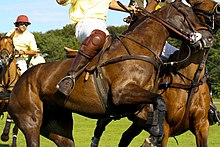Equipment
The basic dress of a player is a protective helmet (usually of a distinctive color, to be distinguished at the considerable distance from which onlookers are watching the game), riding boots to just below the knees, white trousers (often ordinary denim jeans), and a colored shirt bearing the number of the player's position. Optional equipment includes one or two gloves, wristbands, kneepads (mandatory in some clubs), spurs, face mask, and a whip. The only piece of equipment required by the United States Polo Association (USPA) rules is the helmet or cap with a chin strap.The outdoor polo ball is made of a high-impact plastic, but was formerly made of either bamboo or willow root. The indoor polo ball is leather-covered and inflated, and is about 4½ inches (11.4 cm) in diameter. The outdoor ball is about 3¼ inches (8.3 cm) in diameter and weighs about four ounces (113.4 g). The polo mallet has a rubber-wrapped grip and a webbed thong, called a sling, for wrapping around the thumb. The shaft is made of manau-cane (not bamboo because it is hollowed) although an increasing number of mallets today are made from Composite materials. Wood Mallets in NZ is the pioneer of this technology. The heads of the mallet are generally a cigar shape made from a hardwood called tipa, approximately 9 1/4" inches in length. The mallet head weighs from 160 grams to 240 grams, depending on player preference and the type of wood used, and the shaft can vary in weight and flexibility depending on the player’s preference. The weight of the mallet head is of important consideration for the more seasoned players. Female players often use lighter mallets than male players. For some polo players, the length of the polo mallet depends on the size of the horse: the taller the horse, the longer the mallet. However, some players prefer to use a single length of mallet regardless of the height of the horse. Either way, playing horses of differing heights requires some adjustment by the rider. Variable sizes of the mallet typically range from 50 inches to 53 inches. The ball is struck with the longer sides of the mallet head rather than its round and flat tips.
Polo saddles are English-style, close contact, similar to jumping saddles although most polo saddles lack a flap under the billets, having instead a saddle blanket. Some players omit the saddle blanket. A breastplate is added, usually attached to the front billet. A tie-down (standing Martingale) may be used: if so, for safety a breastplate is a necessity. Usually the tie-down is supported by a neck strap. An overgirth may be used. The stirrup irons are heavier than most, and the stirrup leathers are wider and thicker, for added safety when the player stands in the stirrups. The legs of the pony are wrapped with polo wraps from below the knee to the fetlock to prevent injury. Jumping (open front) or gallop boots are sometimes used along with the polo wraps for added protection. Often, these wraps match the team colors. The pony's mane is roached (hogged), and its tail is braided so that it will not snag the rider's mallet.
The bit frequently is a gag bit or Pelham bit. If a gag bit, there will be a drop noseband in addition to the cavesson supporting the tie-down. There frequently will be two sets of reins, and one set of reins frequently will be a draw rein.
 11:14 PM
11:14 PM
 MUHAMMAD USMAN AWAN
MUHAMMAD USMAN AWAN




 Posted in:
Posted in: 






0 comments:
Post a Comment